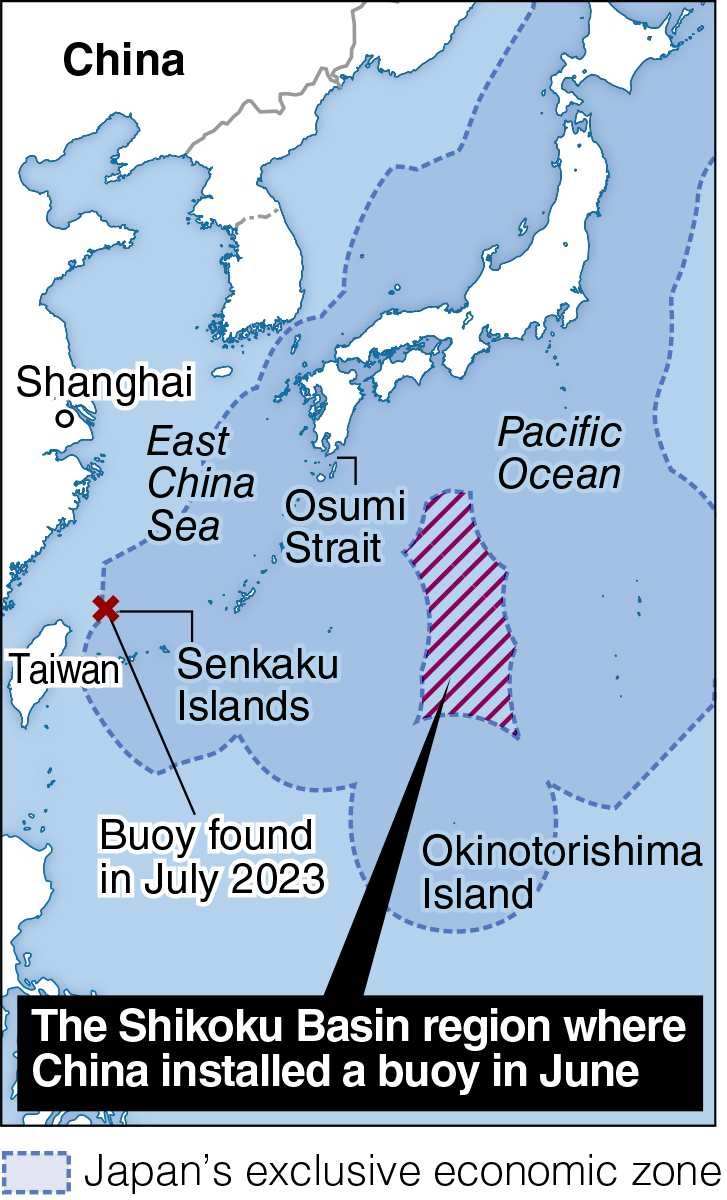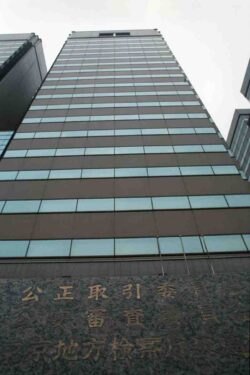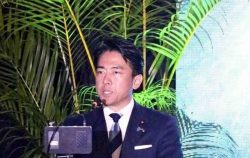China Installs Buoy on Japan’s Continental Shelf in Shikoku Basin Region; Government to Examine Purpose of Unusual Move in Pacific Ocean

15:51 JST, July 5, 2024
A Chinese government vessel in June installed a buoy on Japan’s continental shelf in the Shikoku Basin region, north of Japan’s southernmost Okinotorishima Island, The Yomiuri Shimbun has learned.
While China has previously installed buoys in the East China Sea including an area near the Senkaku Islands in Okinawa Prefecture, it is quite unusual for the country to install a buoy in the waters under the jurisdiction of Japan on the Pacific Ocean. The government is examining the purpose and other details of the buoy.
The Xiangyanghong 22, a large Chinese working ship, in July 2023 installed an ocean survey buoy with a diameter of about 10 meters in Japan’s exclusive economic zone about 80 kilometers northwest of the Senkaku’s Uotsuri Island without permission. It is believed that wave and other data collected by the buoy is transmitted to China using satellites. The government has demanded the immediate removal of the buoy at summit meetings and foreign ministerial meetings between Japan and China, among other occasions, but China has not responded to the requests.
According to multiple government sources, Xiangyanghong 22 left Shanghai on June 5 this year and arrived in the Pacific Ocean via the Osumi Strait off the coast of Kagoshima Prefecture. It then installed the buoy in the Shikoku Basin region in mid-June. The buoy is reportedly smaller than the one installed in July 2023 and is equipped with a light emitting device that can be seen from ships traveling nearby at night.
The Shikoku Basin region is surrounded by Japan’s EEZ and covers an area almost equivalent to half the size of Japan, which is 378,000 square kilometers. Since there are no islands in or around the region, it is supposed to be outside the EEZ. However, the U.N. Commission on the Limits of the Continental Shelf (CLCS) recognized the Shikoku Basin region as Japan’s continental shelf in 2012, with Okinotorishima Island as its base point. Under the U.N. Convention on the Law of the Sea, Japan exercises sovereign rights over the continental shelf for the purpose of exploring the sea bed and exploiting its natural resources.
Unlike EEZs, oceanographic surveys conducted in waters above continental selves do not require approval of coastal states. However, mineral resources including rare metals are said to be distributed in the seabed of the region, and if the recently installed buoy is related to the exploration of the seabed and other such activities, it is highly likely that it violates the U.N. convention.
On the other hand, China claims that Okinotorishima is not an island but a rock and that neither an EEZ nor a continental shelf can be established based on it. China has repeatedly conducted oceanographic surveys and military exercises in the western Pacific including areas near the island. Since it could install buoys in Japan’s EEZ in the Pacific Ocean side in the future, just like in the East China Sea, the government is stepping up vigilance and surveillance activities.
Hayashi: ‘Disappointed’
“It is regretful that China installed the buoy without explaining its purpose, plan and other details,” Chief Cabinet Secretary Yoshimasa Hayashi said at a press conference Friday.
Hayashi also said that Tokyo has asked Beijing to provide a transparent explanation about it. According to him, China has explained that the buoy is designed to observe tsunami and is not intended to violate Japan’s rights over the continental shelf.
"Politics" POPULAR ARTICLE
-

Japanese Language Requirement Eyed for Permanent Residency Status; LDP Plans Revisions of Laws on Foreigners
-
-250x167.jpg)
Japan Eyes Plan to Accept Up To 1.23 Mil. Foreign Workers by End of Fiscal 2028
-

AI-Driven ‘Zero Clicks’ Phenomenon Threatens Democracy; News Outlets Must Be Able to Recover Costs, Stay Independent
-

Japanese Public, Private Sectors to Partner on ¥3 Tril. Project to Develop Domestic AI, SoftBank to Be Key Firm Involved
-

Japan’s Defense Ministry to Extend Reemployment Support for SDF Personnel to Age 65; Move Comes Amid Ongoing Labor Shortage
JN ACCESS RANKING
-

As Chinese Tourists Shun Japan, Hotels and Stores Suffer
-

BOJ Gov. Ueda: Highly Likely Mechanism for Rising Wages, Prices Will Be Maintained
-

Core Inflation in Tokyo Slows in December but Stays above BOJ Target
-

Osaka-Kansai Expo’s Economic Impact Estimated at ¥3.6 Trillion, Takes Actual Visitor Numbers into Account
-

Japan Govt Adopts Measures to Curb Mega Solar Power Plant Projects Amid Environmental Concerns

























